Financial Accounting Theory: Measurement in Financial Reporting
VerifiedAdded on 2022/08/11
|11
|3268
|30
Report
AI Summary
This report delves into the core concepts of financial accounting theory, with a specific focus on accounting measurement. It begins with an introduction to the significance of financial accounting and its role in organizational decision-making, followed by an in-depth analysis of accounting measurement itself, defining its role in evaluating financial data and company performance. The report then examines various methods of accounting measurement for assets and liabilities, including historical cost, fair value, deprival value, and realizable value, providing insights into their applications and implications. Similarly, it explores different approaches to inventory measurement such as LIFO, FIFO, and weighted average cost. The report also discusses regulatory requirements in accounting measurement, emphasizing the importance of regulations in ensuring accurate financial reporting and preventing fraud. Furthermore, it covers the hierarchies of accounting management, including fair value measurement, and various accounting measurement approaches like single and mixed measurement approaches. The report concludes by addressing the development of measurement activities, the issues in financial reporting, and the application of measurement under IFRS.
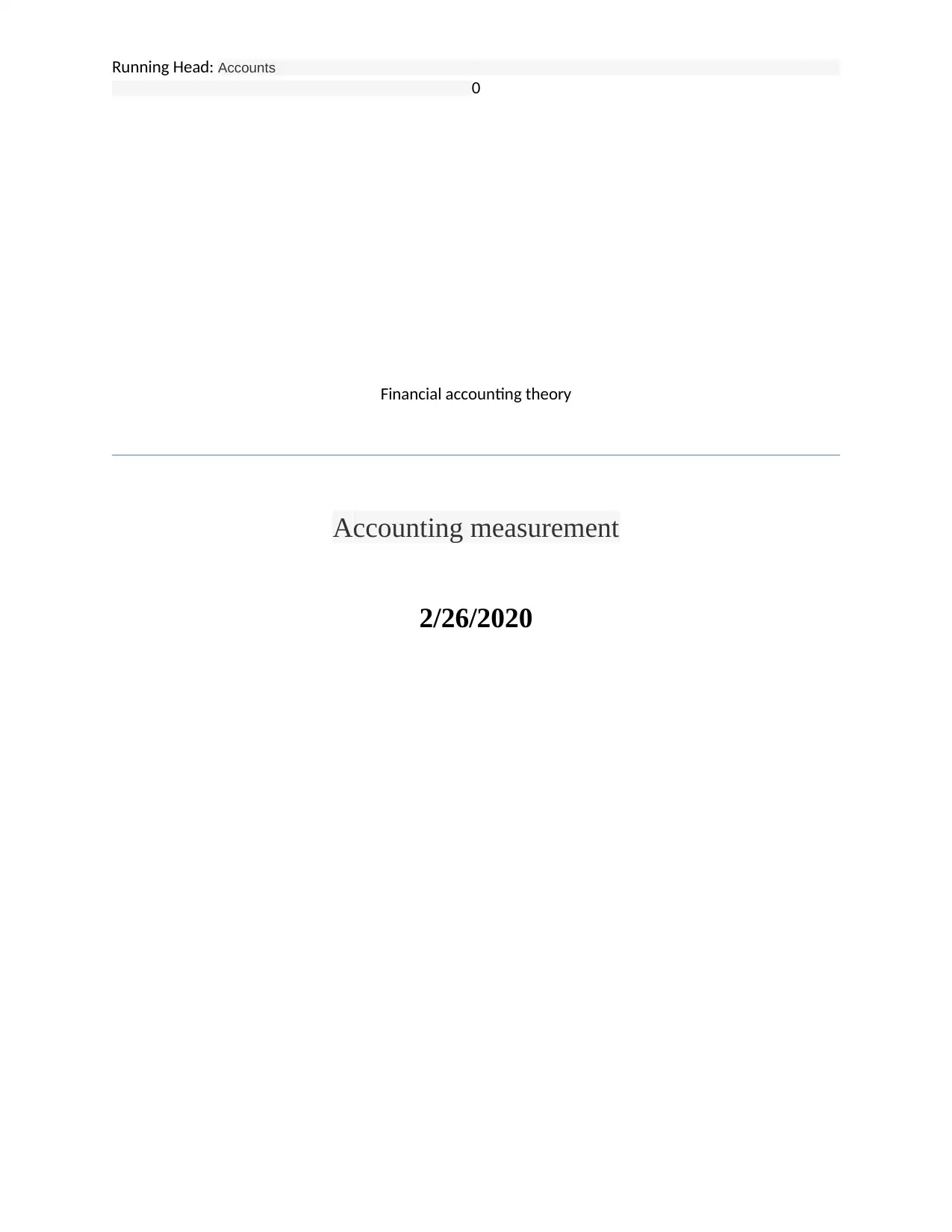
Running Head: Accounts
0
Financial accounting theory
Accounting measurement
2/26/2020
0
Financial accounting theory
Accounting measurement
2/26/2020
Paraphrase This Document
Need a fresh take? Get an instant paraphrase of this document with our AI Paraphraser
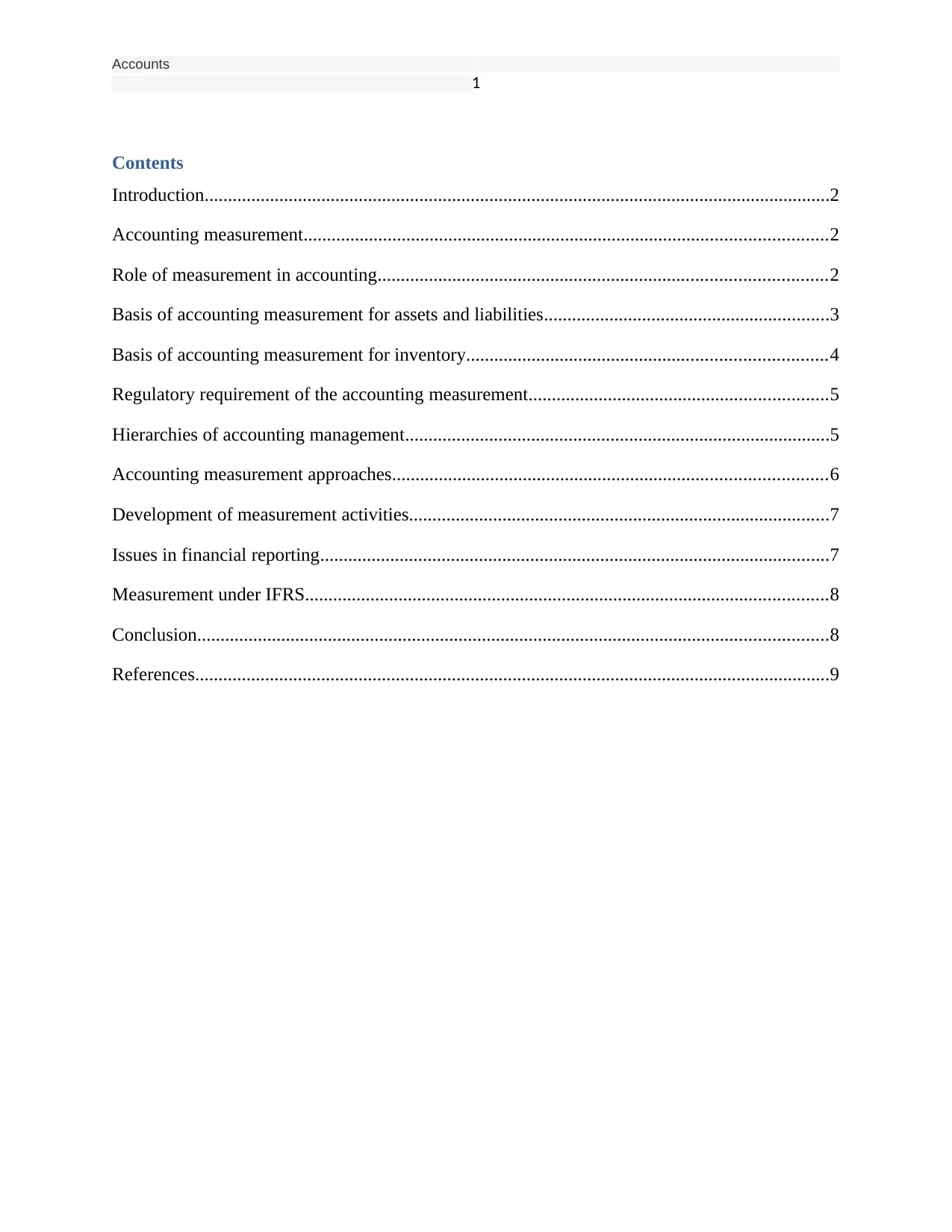
Accounts
1
Contents
Introduction......................................................................................................................................2
Accounting measurement................................................................................................................2
Role of measurement in accounting................................................................................................2
Basis of accounting measurement for assets and liabilities.............................................................3
Basis of accounting measurement for inventory.............................................................................4
Regulatory requirement of the accounting measurement................................................................5
Hierarchies of accounting management...........................................................................................5
Accounting measurement approaches.............................................................................................6
Development of measurement activities..........................................................................................7
Issues in financial reporting.............................................................................................................7
Measurement under IFRS................................................................................................................8
Conclusion.......................................................................................................................................8
References........................................................................................................................................9
1
Contents
Introduction......................................................................................................................................2
Accounting measurement................................................................................................................2
Role of measurement in accounting................................................................................................2
Basis of accounting measurement for assets and liabilities.............................................................3
Basis of accounting measurement for inventory.............................................................................4
Regulatory requirement of the accounting measurement................................................................5
Hierarchies of accounting management...........................................................................................5
Accounting measurement approaches.............................................................................................6
Development of measurement activities..........................................................................................7
Issues in financial reporting.............................................................................................................7
Measurement under IFRS................................................................................................................8
Conclusion.......................................................................................................................................8
References........................................................................................................................................9
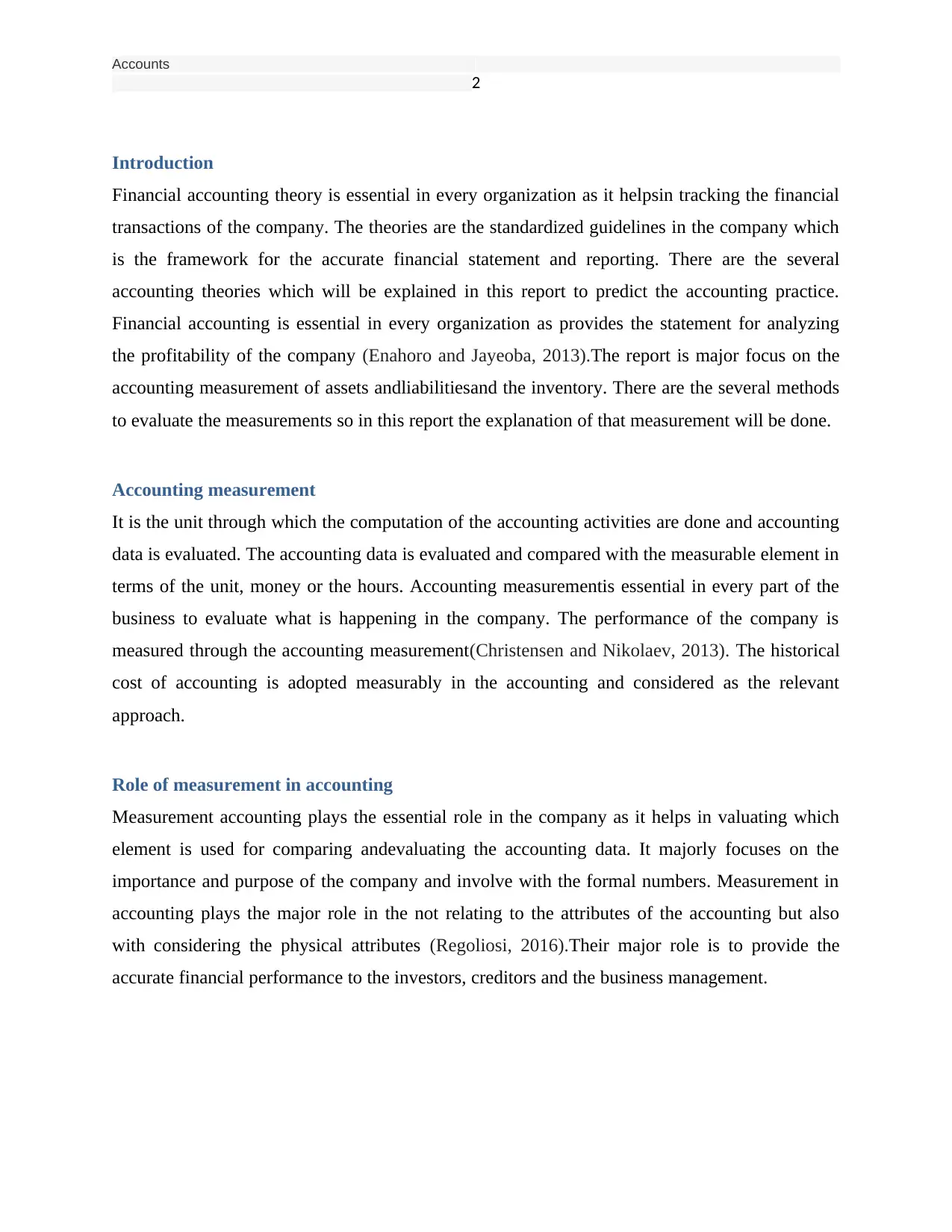
Accounts
2
Introduction
Financial accounting theory is essential in every organization as it helpsin tracking the financial
transactions of the company. The theories are the standardized guidelines in the company which
is the framework for the accurate financial statement and reporting. There are the several
accounting theories which will be explained in this report to predict the accounting practice.
Financial accounting is essential in every organization as provides the statement for analyzing
the profitability of the company (Enahoro and Jayeoba, 2013).The report is major focus on the
accounting measurement of assets andliabilitiesand the inventory. There are the several methods
to evaluate the measurements so in this report the explanation of that measurement will be done.
Accounting measurement
It is the unit through which the computation of the accounting activities are done and accounting
data is evaluated. The accounting data is evaluated and compared with the measurable element in
terms of the unit, money or the hours. Accounting measurementis essential in every part of the
business to evaluate what is happening in the company. The performance of the company is
measured through the accounting measurement(Christensen and Nikolaev, 2013). The historical
cost of accounting is adopted measurably in the accounting and considered as the relevant
approach.
Role of measurement in accounting
Measurement accounting plays the essential role in the company as it helps in valuating which
element is used for comparing andevaluating the accounting data. It majorly focuses on the
importance and purpose of the company and involve with the formal numbers. Measurement in
accounting plays the major role in the not relating to the attributes of the accounting but also
with considering the physical attributes (Regoliosi, 2016).Their major role is to provide the
accurate financial performance to the investors, creditors and the business management.
2
Introduction
Financial accounting theory is essential in every organization as it helpsin tracking the financial
transactions of the company. The theories are the standardized guidelines in the company which
is the framework for the accurate financial statement and reporting. There are the several
accounting theories which will be explained in this report to predict the accounting practice.
Financial accounting is essential in every organization as provides the statement for analyzing
the profitability of the company (Enahoro and Jayeoba, 2013).The report is major focus on the
accounting measurement of assets andliabilitiesand the inventory. There are the several methods
to evaluate the measurements so in this report the explanation of that measurement will be done.
Accounting measurement
It is the unit through which the computation of the accounting activities are done and accounting
data is evaluated. The accounting data is evaluated and compared with the measurable element in
terms of the unit, money or the hours. Accounting measurementis essential in every part of the
business to evaluate what is happening in the company. The performance of the company is
measured through the accounting measurement(Christensen and Nikolaev, 2013). The historical
cost of accounting is adopted measurably in the accounting and considered as the relevant
approach.
Role of measurement in accounting
Measurement accounting plays the essential role in the company as it helps in valuating which
element is used for comparing andevaluating the accounting data. It majorly focuses on the
importance and purpose of the company and involve with the formal numbers. Measurement in
accounting plays the major role in the not relating to the attributes of the accounting but also
with considering the physical attributes (Regoliosi, 2016).Their major role is to provide the
accurate financial performance to the investors, creditors and the business management.
⊘ This is a preview!⊘
Do you want full access?
Subscribe today to unlock all pages.

Trusted by 1+ million students worldwide
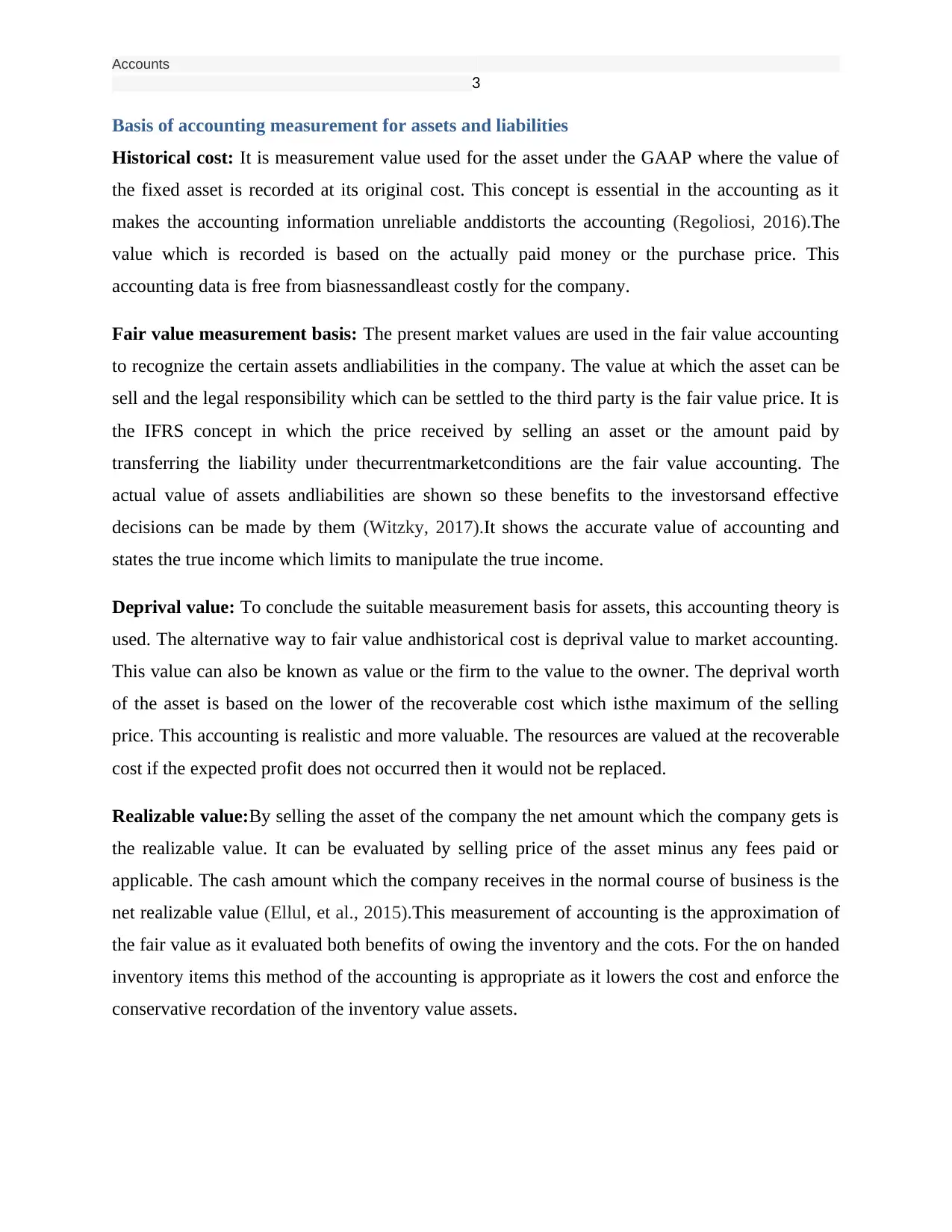
Accounts
3
Basis of accounting measurement for assets and liabilities
Historical cost: It is measurement value used for the asset under the GAAP where the value of
the fixed asset is recorded at its original cost. This concept is essential in the accounting as it
makes the accounting information unreliable anddistorts the accounting (Regoliosi, 2016).The
value which is recorded is based on the actually paid money or the purchase price. This
accounting data is free from biasnessandleast costly for the company.
Fair value measurement basis: The present market values are used in the fair value accounting
to recognize the certain assets andliabilities in the company. The value at which the asset can be
sell and the legal responsibility which can be settled to the third party is the fair value price. It is
the IFRS concept in which the price received by selling an asset or the amount paid by
transferring the liability under thecurrentmarketconditions are the fair value accounting. The
actual value of assets andliabilities are shown so these benefits to the investorsand effective
decisions can be made by them (Witzky, 2017).It shows the accurate value of accounting and
states the true income which limits to manipulate the true income.
Deprival value: To conclude the suitable measurement basis for assets, this accounting theory is
used. The alternative way to fair value andhistorical cost is deprival value to market accounting.
This value can also be known as value or the firm to the value to the owner. The deprival worth
of the asset is based on the lower of the recoverable cost which isthe maximum of the selling
price. This accounting is realistic and more valuable. The resources are valued at the recoverable
cost if the expected profit does not occurred then it would not be replaced.
Realizable value:By selling the asset of the company the net amount which the company gets is
the realizable value. It can be evaluated by selling price of the asset minus any fees paid or
applicable. The cash amount which the company receives in the normal course of business is the
net realizable value (Ellul, et al., 2015).This measurement of accounting is the approximation of
the fair value as it evaluated both benefits of owing the inventory and the cots. For the on handed
inventory items this method of the accounting is appropriate as it lowers the cost and enforce the
conservative recordation of the inventory value assets.
3
Basis of accounting measurement for assets and liabilities
Historical cost: It is measurement value used for the asset under the GAAP where the value of
the fixed asset is recorded at its original cost. This concept is essential in the accounting as it
makes the accounting information unreliable anddistorts the accounting (Regoliosi, 2016).The
value which is recorded is based on the actually paid money or the purchase price. This
accounting data is free from biasnessandleast costly for the company.
Fair value measurement basis: The present market values are used in the fair value accounting
to recognize the certain assets andliabilities in the company. The value at which the asset can be
sell and the legal responsibility which can be settled to the third party is the fair value price. It is
the IFRS concept in which the price received by selling an asset or the amount paid by
transferring the liability under thecurrentmarketconditions are the fair value accounting. The
actual value of assets andliabilities are shown so these benefits to the investorsand effective
decisions can be made by them (Witzky, 2017).It shows the accurate value of accounting and
states the true income which limits to manipulate the true income.
Deprival value: To conclude the suitable measurement basis for assets, this accounting theory is
used. The alternative way to fair value andhistorical cost is deprival value to market accounting.
This value can also be known as value or the firm to the value to the owner. The deprival worth
of the asset is based on the lower of the recoverable cost which isthe maximum of the selling
price. This accounting is realistic and more valuable. The resources are valued at the recoverable
cost if the expected profit does not occurred then it would not be replaced.
Realizable value:By selling the asset of the company the net amount which the company gets is
the realizable value. It can be evaluated by selling price of the asset minus any fees paid or
applicable. The cash amount which the company receives in the normal course of business is the
net realizable value (Ellul, et al., 2015).This measurement of accounting is the approximation of
the fair value as it evaluated both benefits of owing the inventory and the cots. For the on handed
inventory items this method of the accounting is appropriate as it lowers the cost and enforce the
conservative recordation of the inventory value assets.
Paraphrase This Document
Need a fresh take? Get an instant paraphrase of this document with our AI Paraphraser
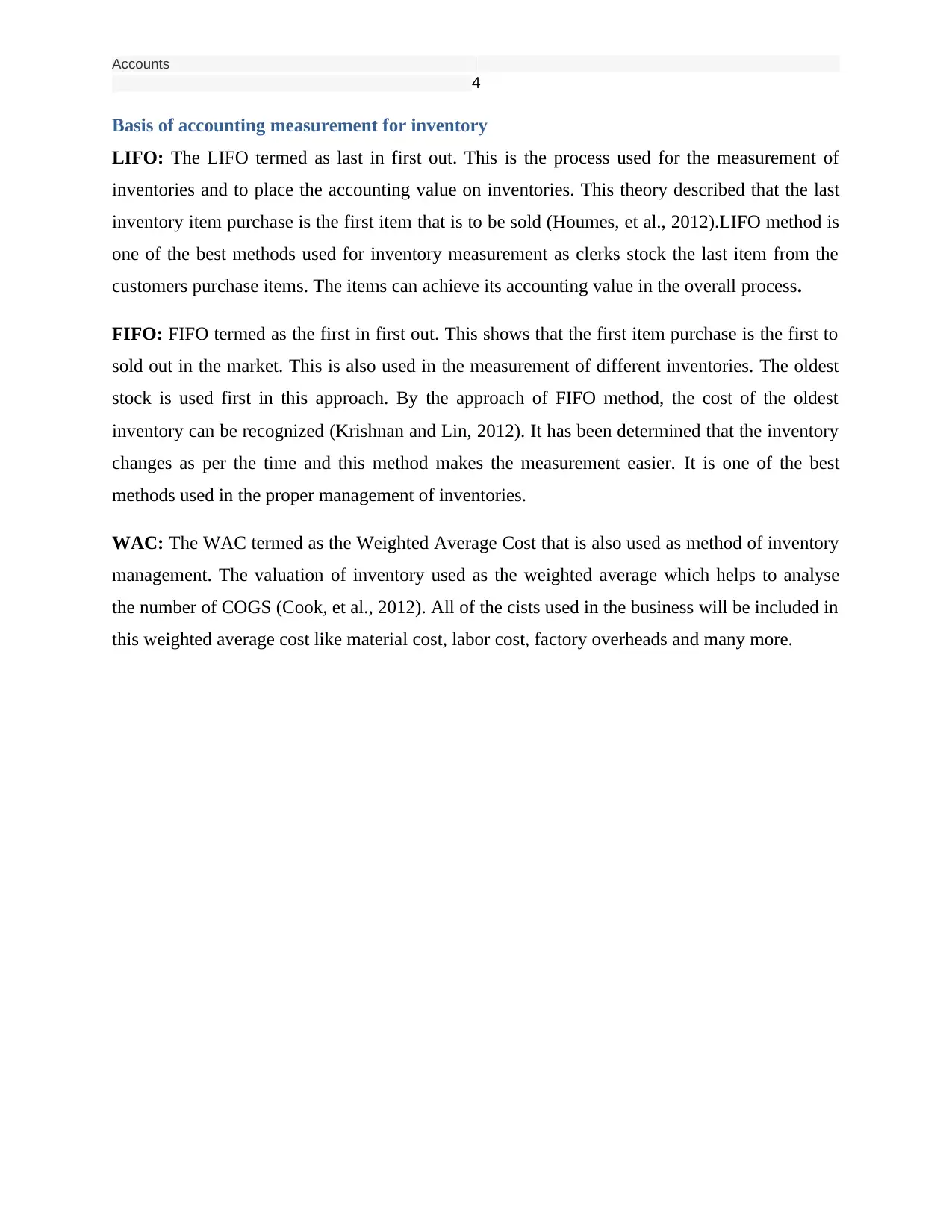
Accounts
4
Basis of accounting measurement for inventory
LIFO: The LIFO termed as last in first out. This is the process used for the measurement of
inventories and to place the accounting value on inventories. This theory described that the last
inventory item purchase is the first item that is to be sold (Houmes, et al., 2012).LIFO method is
one of the best methods used for inventory measurement as clerks stock the last item from the
customers purchase items. The items can achieve its accounting value in the overall process.
FIFO: FIFO termed as the first in first out. This shows that the first item purchase is the first to
sold out in the market. This is also used in the measurement of different inventories. The oldest
stock is used first in this approach. By the approach of FIFO method, the cost of the oldest
inventory can be recognized (Krishnan and Lin, 2012). It has been determined that the inventory
changes as per the time and this method makes the measurement easier. It is one of the best
methods used in the proper management of inventories.
WAC: The WAC termed as the Weighted Average Cost that is also used as method of inventory
management. The valuation of inventory used as the weighted average which helps to analyse
the number of COGS (Cook, et al., 2012). All of the cists used in the business will be included in
this weighted average cost like material cost, labor cost, factory overheads and many more.
4
Basis of accounting measurement for inventory
LIFO: The LIFO termed as last in first out. This is the process used for the measurement of
inventories and to place the accounting value on inventories. This theory described that the last
inventory item purchase is the first item that is to be sold (Houmes, et al., 2012).LIFO method is
one of the best methods used for inventory measurement as clerks stock the last item from the
customers purchase items. The items can achieve its accounting value in the overall process.
FIFO: FIFO termed as the first in first out. This shows that the first item purchase is the first to
sold out in the market. This is also used in the measurement of different inventories. The oldest
stock is used first in this approach. By the approach of FIFO method, the cost of the oldest
inventory can be recognized (Krishnan and Lin, 2012). It has been determined that the inventory
changes as per the time and this method makes the measurement easier. It is one of the best
methods used in the proper management of inventories.
WAC: The WAC termed as the Weighted Average Cost that is also used as method of inventory
management. The valuation of inventory used as the weighted average which helps to analyse
the number of COGS (Cook, et al., 2012). All of the cists used in the business will be included in
this weighted average cost like material cost, labor cost, factory overheads and many more.

Accounts
5
Regulatory requirement of the accounting measurement
The regulations are majorly used in the accounting measurement as regulations are the basic
need for measure the several accounting aspects. Accounting regulation used in the process of
the financial accounting. It is used to give the information that is sued by the external users like
investors, creditors, government and other customers. The decision-making process is majorly
used in the accounting regulations. The legal framework is also used in the regulations and rules
related to the financial accounting and it are important for the accounting regulation. All the
financial statement needs proper regulation so that fraud cannot be occurred (Villasensor, et al,
2015).The regulators use the two systems that controls all the operations related to the financial
accounting. The first system is known as the Uniform System of accounts and the second system
used to control the financial information is accounting separation.
The regulations create difficulties in which the overall process can be controlled. The financial
measurement affects the overall regulations. These regulations are to essential for the proper
measurement and this is one of the major parts used in the management of financial accounting.
Accounting rules include the different statements the include the proper guidance to record the
several transactions (Chen, et al., 2015). The financial analysis becomes easier by using the two
systems of regulatory reports. The accounting separation is one of the best systems used in the
overall process of accounting.
Hierarchies of accounting management
The hierarchy of accounting management is necessary for the overall process of the business as
the management of accounting is also necessary for the business. The finances are the key to
achieve success in the business market. The understanding is necessary for use the accounting
hierarchy in the business process (Friedrich, 2015). The small business achieves more success by
using the hierarchy of the accounting measurement.
The hierarchies of accounting measurement include fair value that is essential for the accounting
process of business. The measurement of fair value is important in the overall process as it
permits the use of different values in the business. The Fair Value measurement provides IFRS
framework that is important in the accounting hierarchy. The entity specific measurement is also
5
Regulatory requirement of the accounting measurement
The regulations are majorly used in the accounting measurement as regulations are the basic
need for measure the several accounting aspects. Accounting regulation used in the process of
the financial accounting. It is used to give the information that is sued by the external users like
investors, creditors, government and other customers. The decision-making process is majorly
used in the accounting regulations. The legal framework is also used in the regulations and rules
related to the financial accounting and it are important for the accounting regulation. All the
financial statement needs proper regulation so that fraud cannot be occurred (Villasensor, et al,
2015).The regulators use the two systems that controls all the operations related to the financial
accounting. The first system is known as the Uniform System of accounts and the second system
used to control the financial information is accounting separation.
The regulations create difficulties in which the overall process can be controlled. The financial
measurement affects the overall regulations. These regulations are to essential for the proper
measurement and this is one of the major parts used in the management of financial accounting.
Accounting rules include the different statements the include the proper guidance to record the
several transactions (Chen, et al., 2015). The financial analysis becomes easier by using the two
systems of regulatory reports. The accounting separation is one of the best systems used in the
overall process of accounting.
Hierarchies of accounting management
The hierarchy of accounting management is necessary for the overall process of the business as
the management of accounting is also necessary for the business. The finances are the key to
achieve success in the business market. The understanding is necessary for use the accounting
hierarchy in the business process (Friedrich, 2015). The small business achieves more success by
using the hierarchy of the accounting measurement.
The hierarchies of accounting measurement include fair value that is essential for the accounting
process of business. The measurement of fair value is important in the overall process as it
permits the use of different values in the business. The Fair Value measurement provides IFRS
framework that is important in the accounting hierarchy. The entity specific measurement is also
⊘ This is a preview!⊘
Do you want full access?
Subscribe today to unlock all pages.

Trusted by 1+ million students worldwide
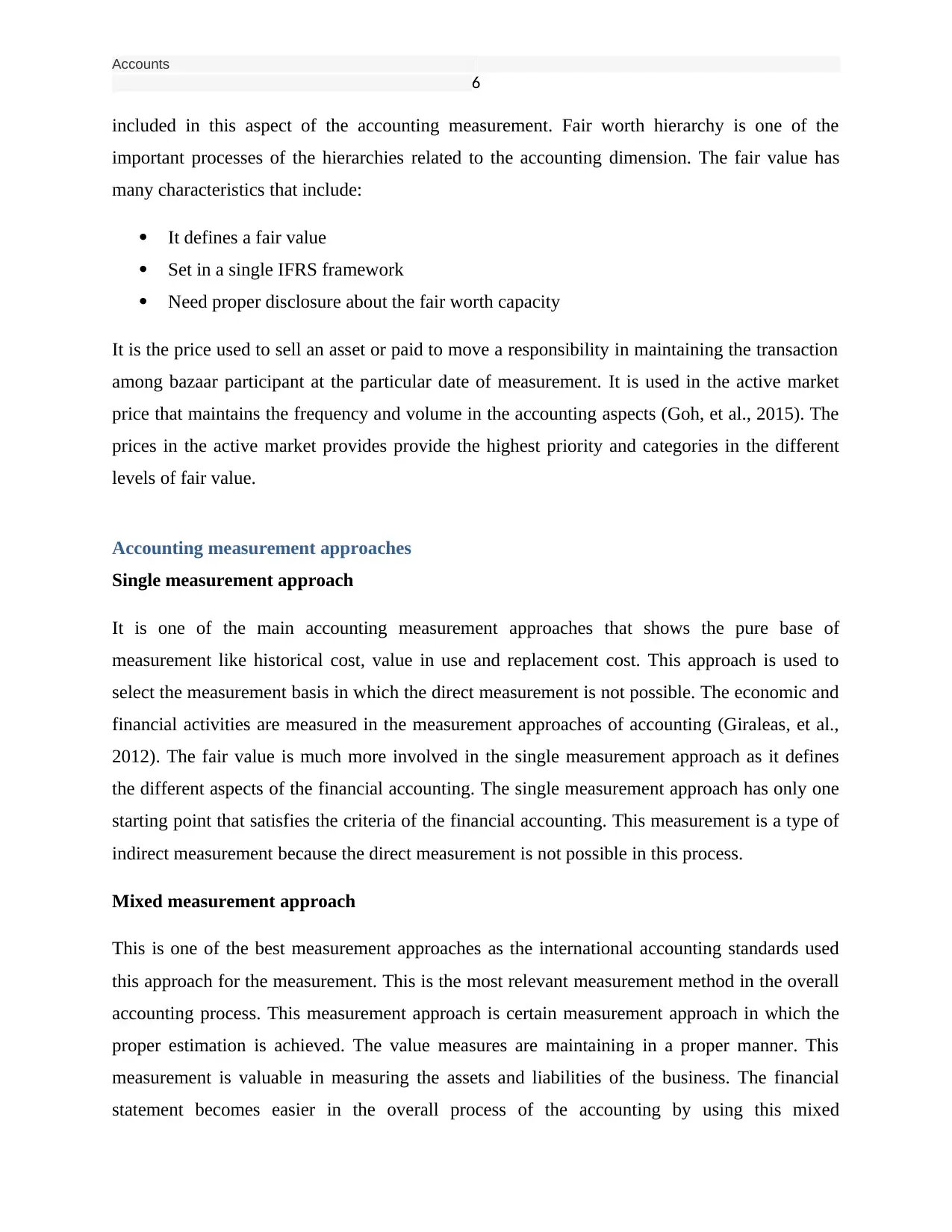
Accounts
6
included in this aspect of the accounting measurement. Fair worth hierarchy is one of the
important processes of the hierarchies related to the accounting dimension. The fair value has
many characteristics that include:
It defines a fair value
Set in a single IFRS framework
Need proper disclosure about the fair worth capacity
It is the price used to sell an asset or paid to move a responsibility in maintaining the transaction
among bazaar participant at the particular date of measurement. It is used in the active market
price that maintains the frequency and volume in the accounting aspects (Goh, et al., 2015). The
prices in the active market provides provide the highest priority and categories in the different
levels of fair value.
Accounting measurement approaches
Single measurement approach
It is one of the main accounting measurement approaches that shows the pure base of
measurement like historical cost, value in use and replacement cost. This approach is used to
select the measurement basis in which the direct measurement is not possible. The economic and
financial activities are measured in the measurement approaches of accounting (Giraleas, et al.,
2012). The fair value is much more involved in the single measurement approach as it defines
the different aspects of the financial accounting. The single measurement approach has only one
starting point that satisfies the criteria of the financial accounting. This measurement is a type of
indirect measurement because the direct measurement is not possible in this process.
Mixed measurement approach
This is one of the best measurement approaches as the international accounting standards used
this approach for the measurement. This is the most relevant measurement method in the overall
accounting process. This measurement approach is certain measurement approach in which the
proper estimation is achieved. The value measures are maintaining in a proper manner. This
measurement is valuable in measuring the assets and liabilities of the business. The financial
statement becomes easier in the overall process of the accounting by using this mixed
6
included in this aspect of the accounting measurement. Fair worth hierarchy is one of the
important processes of the hierarchies related to the accounting dimension. The fair value has
many characteristics that include:
It defines a fair value
Set in a single IFRS framework
Need proper disclosure about the fair worth capacity
It is the price used to sell an asset or paid to move a responsibility in maintaining the transaction
among bazaar participant at the particular date of measurement. It is used in the active market
price that maintains the frequency and volume in the accounting aspects (Goh, et al., 2015). The
prices in the active market provides provide the highest priority and categories in the different
levels of fair value.
Accounting measurement approaches
Single measurement approach
It is one of the main accounting measurement approaches that shows the pure base of
measurement like historical cost, value in use and replacement cost. This approach is used to
select the measurement basis in which the direct measurement is not possible. The economic and
financial activities are measured in the measurement approaches of accounting (Giraleas, et al.,
2012). The fair value is much more involved in the single measurement approach as it defines
the different aspects of the financial accounting. The single measurement approach has only one
starting point that satisfies the criteria of the financial accounting. This measurement is a type of
indirect measurement because the direct measurement is not possible in this process.
Mixed measurement approach
This is one of the best measurement approaches as the international accounting standards used
this approach for the measurement. This is the most relevant measurement method in the overall
accounting process. This measurement approach is certain measurement approach in which the
proper estimation is achieved. The value measures are maintaining in a proper manner. This
measurement is valuable in measuring the assets and liabilities of the business. The financial
statement becomes easier in the overall process of the accounting by using this mixed
Paraphrase This Document
Need a fresh take? Get an instant paraphrase of this document with our AI Paraphraser

Accounts
7
measurement approach (Wikramasinghe and Alawattage, 2012). The investors get better
information by adopting the mixed measurement approach. All the needs of the stakeholders can
be managed by using this approach of measurement. The measurement is one of the essential
process of accounting as it manages all the accounting aspects of the buiness. Among all the
measurement approaches, the mixed measurement is one of the best methods used for the overall
process. The accounting information is necessary for the overall aspects and this can be achieved
by the proper approach of accounting that gives mixed value of the accounting essentials
Development of measurement activities
The development of measurement practices can be done through the financial reporting measures
which are economic activities, economic incentives. The problem perceived in the economic
activities helps in evaluating the measurement practices. The measurementactivities help in
evaluatingand comparing the accounting data so it helps in developing the financial and the
economic activities(Liang and Riedl, 2016).The accounting data is evaluated and compared with
the measurable element in terms of the unit, money or the hours. Accounting measurementis
essential in every part of the business to evaluate what is happening in the company and helps in
developing the measurement activities.
Issues in financial reporting
There are the several issues which have been seen in the financial reporting such as financial
crisis, valuation of the equity transaction, business combinations, etc. There are many predictions
which are done in the accounting so sometimes it turns out the incomplete business activities.
Measurement accounting has been done with the different values so the difference between the
past and the future accounting periods creates the issue in allocating the values. There is the lack
of the comparative data in the financial reports(Fargher and Zhang, 2014). Sometimes the
differences also occur in the financial accounting assets andliabilities due to the lack of the
calculated differences. The reality of the datais not reflected in the financial reporting.
The issues also arise in the forecasting the perpetual cash flows in evaluating the financial ratios,
in scrutinizing the financial statements, etc. The reporting requirement is divergent so there is the
range of the different size thresholds which creates the issues(Spekle and Verbeeten, 2014).
7
measurement approach (Wikramasinghe and Alawattage, 2012). The investors get better
information by adopting the mixed measurement approach. All the needs of the stakeholders can
be managed by using this approach of measurement. The measurement is one of the essential
process of accounting as it manages all the accounting aspects of the buiness. Among all the
measurement approaches, the mixed measurement is one of the best methods used for the overall
process. The accounting information is necessary for the overall aspects and this can be achieved
by the proper approach of accounting that gives mixed value of the accounting essentials
Development of measurement activities
The development of measurement practices can be done through the financial reporting measures
which are economic activities, economic incentives. The problem perceived in the economic
activities helps in evaluating the measurement practices. The measurementactivities help in
evaluatingand comparing the accounting data so it helps in developing the financial and the
economic activities(Liang and Riedl, 2016).The accounting data is evaluated and compared with
the measurable element in terms of the unit, money or the hours. Accounting measurementis
essential in every part of the business to evaluate what is happening in the company and helps in
developing the measurement activities.
Issues in financial reporting
There are the several issues which have been seen in the financial reporting such as financial
crisis, valuation of the equity transaction, business combinations, etc. There are many predictions
which are done in the accounting so sometimes it turns out the incomplete business activities.
Measurement accounting has been done with the different values so the difference between the
past and the future accounting periods creates the issue in allocating the values. There is the lack
of the comparative data in the financial reports(Fargher and Zhang, 2014). Sometimes the
differences also occur in the financial accounting assets andliabilities due to the lack of the
calculated differences. The reality of the datais not reflected in the financial reporting.
The issues also arise in the forecasting the perpetual cash flows in evaluating the financial ratios,
in scrutinizing the financial statements, etc. The reporting requirement is divergent so there is the
range of the different size thresholds which creates the issues(Spekle and Verbeeten, 2014).
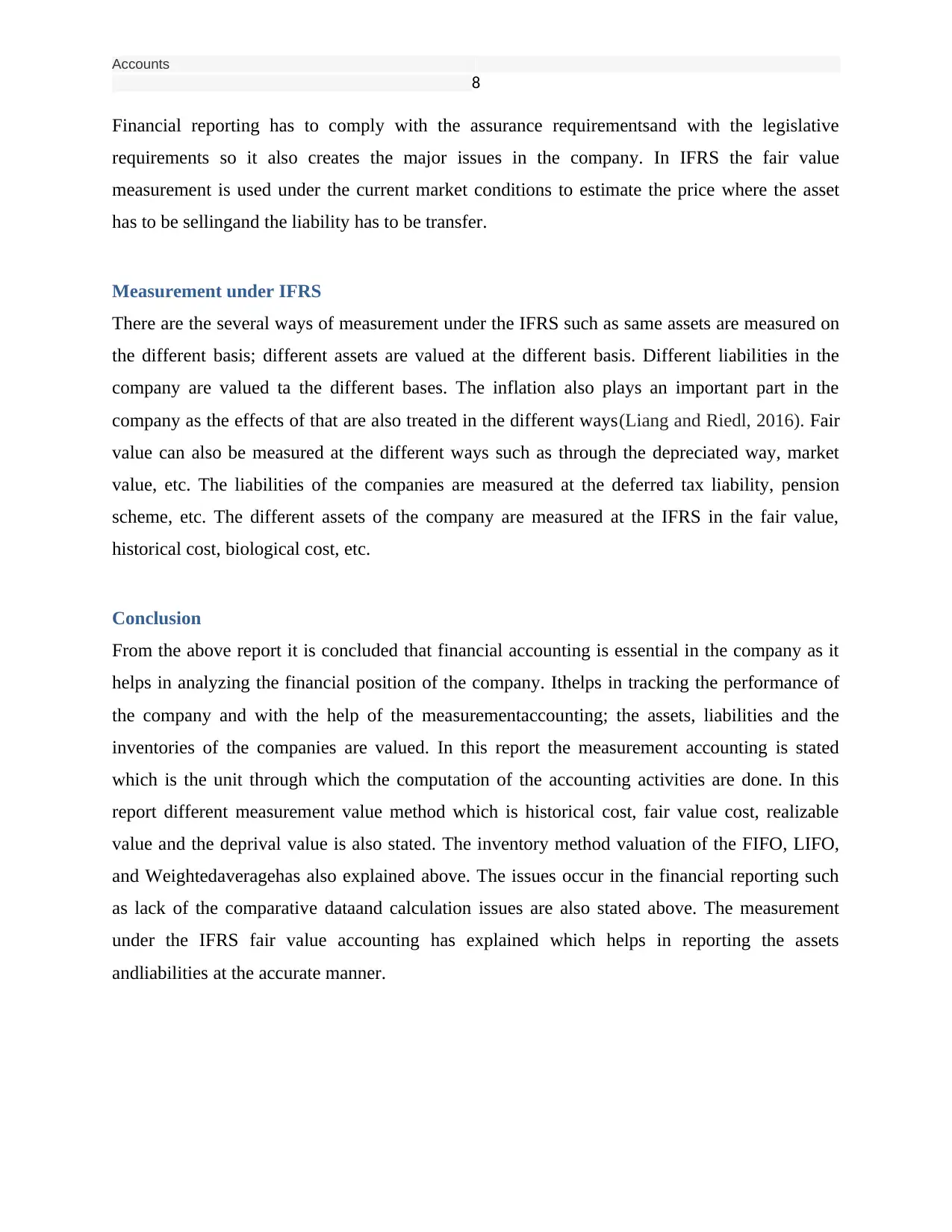
Accounts
8
Financial reporting has to comply with the assurance requirementsand with the legislative
requirements so it also creates the major issues in the company. In IFRS the fair value
measurement is used under the current market conditions to estimate the price where the asset
has to be sellingand the liability has to be transfer.
Measurement under IFRS
There are the several ways of measurement under the IFRS such as same assets are measured on
the different basis; different assets are valued at the different basis. Different liabilities in the
company are valued ta the different bases. The inflation also plays an important part in the
company as the effects of that are also treated in the different ways(Liang and Riedl, 2016). Fair
value can also be measured at the different ways such as through the depreciated way, market
value, etc. The liabilities of the companies are measured at the deferred tax liability, pension
scheme, etc. The different assets of the company are measured at the IFRS in the fair value,
historical cost, biological cost, etc.
Conclusion
From the above report it is concluded that financial accounting is essential in the company as it
helps in analyzing the financial position of the company. Ithelps in tracking the performance of
the company and with the help of the measurementaccounting; the assets, liabilities and the
inventories of the companies are valued. In this report the measurement accounting is stated
which is the unit through which the computation of the accounting activities are done. In this
report different measurement value method which is historical cost, fair value cost, realizable
value and the deprival value is also stated. The inventory method valuation of the FIFO, LIFO,
and Weightedaveragehas also explained above. The issues occur in the financial reporting such
as lack of the comparative dataand calculation issues are also stated above. The measurement
under the IFRS fair value accounting has explained which helps in reporting the assets
andliabilities at the accurate manner.
8
Financial reporting has to comply with the assurance requirementsand with the legislative
requirements so it also creates the major issues in the company. In IFRS the fair value
measurement is used under the current market conditions to estimate the price where the asset
has to be sellingand the liability has to be transfer.
Measurement under IFRS
There are the several ways of measurement under the IFRS such as same assets are measured on
the different basis; different assets are valued at the different basis. Different liabilities in the
company are valued ta the different bases. The inflation also plays an important part in the
company as the effects of that are also treated in the different ways(Liang and Riedl, 2016). Fair
value can also be measured at the different ways such as through the depreciated way, market
value, etc. The liabilities of the companies are measured at the deferred tax liability, pension
scheme, etc. The different assets of the company are measured at the IFRS in the fair value,
historical cost, biological cost, etc.
Conclusion
From the above report it is concluded that financial accounting is essential in the company as it
helps in analyzing the financial position of the company. Ithelps in tracking the performance of
the company and with the help of the measurementaccounting; the assets, liabilities and the
inventories of the companies are valued. In this report the measurement accounting is stated
which is the unit through which the computation of the accounting activities are done. In this
report different measurement value method which is historical cost, fair value cost, realizable
value and the deprival value is also stated. The inventory method valuation of the FIFO, LIFO,
and Weightedaveragehas also explained above. The issues occur in the financial reporting such
as lack of the comparative dataand calculation issues are also stated above. The measurement
under the IFRS fair value accounting has explained which helps in reporting the assets
andliabilities at the accurate manner.
⊘ This is a preview!⊘
Do you want full access?
Subscribe today to unlock all pages.

Trusted by 1+ million students worldwide
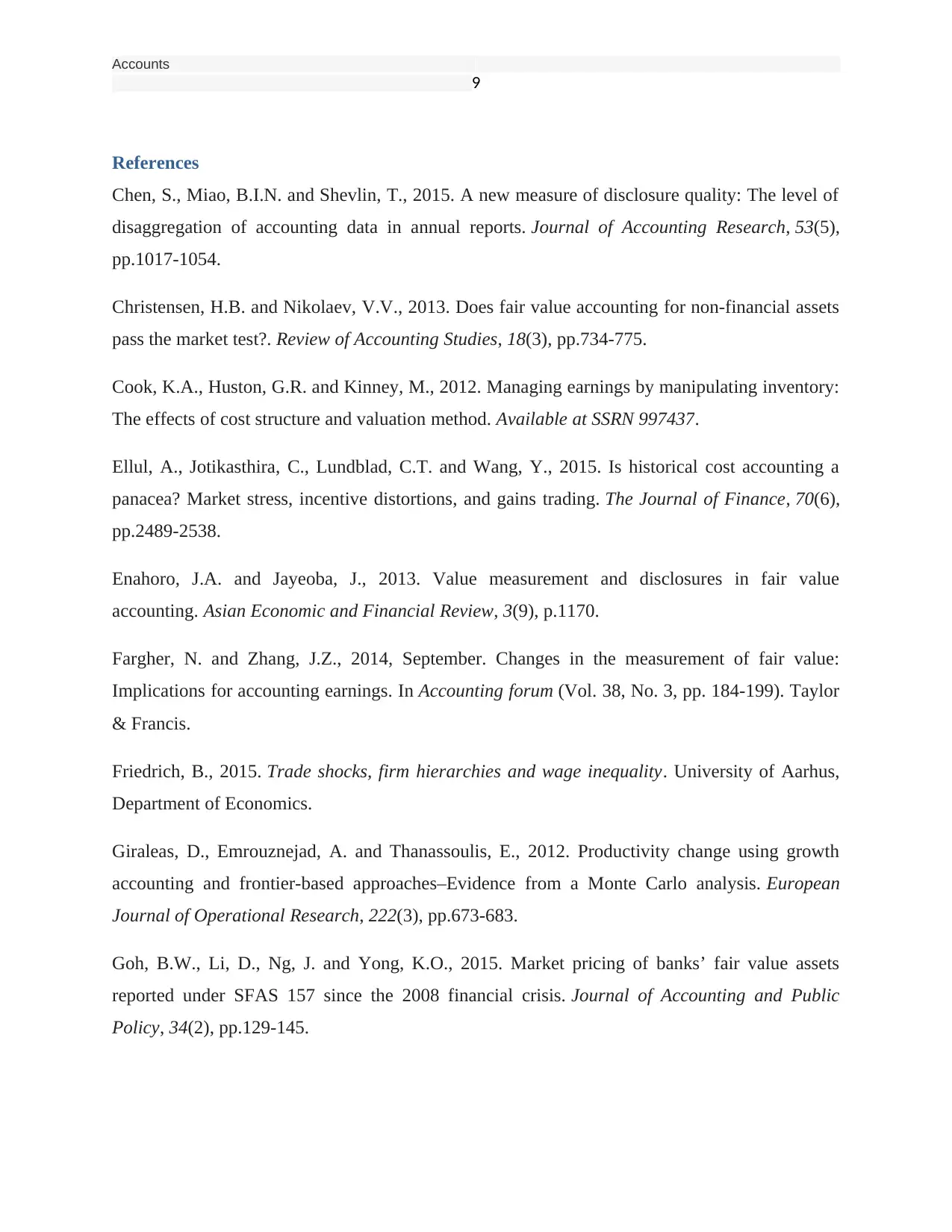
Accounts
9
References
Chen, S., Miao, B.I.N. and Shevlin, T., 2015. A new measure of disclosure quality: The level of
disaggregation of accounting data in annual reports. Journal of Accounting Research, 53(5),
pp.1017-1054.
Christensen, H.B. and Nikolaev, V.V., 2013. Does fair value accounting for non-financial assets
pass the market test?. Review of Accounting Studies, 18(3), pp.734-775.
Cook, K.A., Huston, G.R. and Kinney, M., 2012. Managing earnings by manipulating inventory:
The effects of cost structure and valuation method. Available at SSRN 997437.
Ellul, A., Jotikasthira, C., Lundblad, C.T. and Wang, Y., 2015. Is historical cost accounting a
panacea? Market stress, incentive distortions, and gains trading. The Journal of Finance, 70(6),
pp.2489-2538.
Enahoro, J.A. and Jayeoba, J., 2013. Value measurement and disclosures in fair value
accounting. Asian Economic and Financial Review, 3(9), p.1170.
Fargher, N. and Zhang, J.Z., 2014, September. Changes in the measurement of fair value:
Implications for accounting earnings. In Accounting forum (Vol. 38, No. 3, pp. 184-199). Taylor
& Francis.
Friedrich, B., 2015. Trade shocks, firm hierarchies and wage inequality. University of Aarhus,
Department of Economics.
Giraleas, D., Emrouznejad, A. and Thanassoulis, E., 2012. Productivity change using growth
accounting and frontier-based approaches–Evidence from a Monte Carlo analysis. European
Journal of Operational Research, 222(3), pp.673-683.
Goh, B.W., Li, D., Ng, J. and Yong, K.O., 2015. Market pricing of banks’ fair value assets
reported under SFAS 157 since the 2008 financial crisis. Journal of Accounting and Public
Policy, 34(2), pp.129-145.
9
References
Chen, S., Miao, B.I.N. and Shevlin, T., 2015. A new measure of disclosure quality: The level of
disaggregation of accounting data in annual reports. Journal of Accounting Research, 53(5),
pp.1017-1054.
Christensen, H.B. and Nikolaev, V.V., 2013. Does fair value accounting for non-financial assets
pass the market test?. Review of Accounting Studies, 18(3), pp.734-775.
Cook, K.A., Huston, G.R. and Kinney, M., 2012. Managing earnings by manipulating inventory:
The effects of cost structure and valuation method. Available at SSRN 997437.
Ellul, A., Jotikasthira, C., Lundblad, C.T. and Wang, Y., 2015. Is historical cost accounting a
panacea? Market stress, incentive distortions, and gains trading. The Journal of Finance, 70(6),
pp.2489-2538.
Enahoro, J.A. and Jayeoba, J., 2013. Value measurement and disclosures in fair value
accounting. Asian Economic and Financial Review, 3(9), p.1170.
Fargher, N. and Zhang, J.Z., 2014, September. Changes in the measurement of fair value:
Implications for accounting earnings. In Accounting forum (Vol. 38, No. 3, pp. 184-199). Taylor
& Francis.
Friedrich, B., 2015. Trade shocks, firm hierarchies and wage inequality. University of Aarhus,
Department of Economics.
Giraleas, D., Emrouznejad, A. and Thanassoulis, E., 2012. Productivity change using growth
accounting and frontier-based approaches–Evidence from a Monte Carlo analysis. European
Journal of Operational Research, 222(3), pp.673-683.
Goh, B.W., Li, D., Ng, J. and Yong, K.O., 2015. Market pricing of banks’ fair value assets
reported under SFAS 157 since the 2008 financial crisis. Journal of Accounting and Public
Policy, 34(2), pp.129-145.
Paraphrase This Document
Need a fresh take? Get an instant paraphrase of this document with our AI Paraphraser
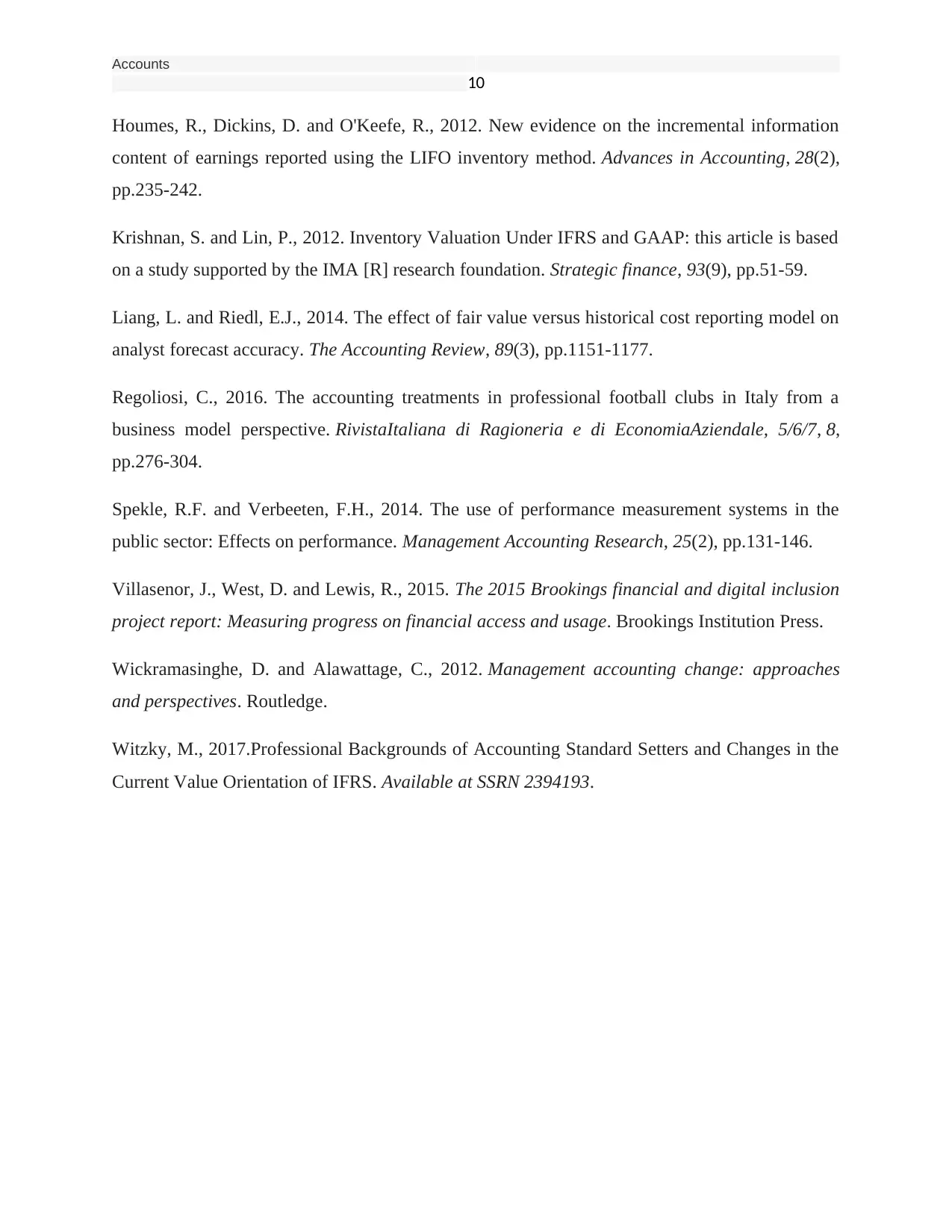
Accounts
10
Houmes, R., Dickins, D. and O'Keefe, R., 2012. New evidence on the incremental information
content of earnings reported using the LIFO inventory method. Advances in Accounting, 28(2),
pp.235-242.
Krishnan, S. and Lin, P., 2012. Inventory Valuation Under IFRS and GAAP: this article is based
on a study supported by the IMA [R] research foundation. Strategic finance, 93(9), pp.51-59.
Liang, L. and Riedl, E.J., 2014. The effect of fair value versus historical cost reporting model on
analyst forecast accuracy. The Accounting Review, 89(3), pp.1151-1177.
Regoliosi, C., 2016. The accounting treatments in professional football clubs in Italy from a
business model perspective. RivistaItaliana di Ragioneria e di EconomiaAziendale, 5/6/7, 8,
pp.276-304.
Spekle, R.F. and Verbeeten, F.H., 2014. The use of performance measurement systems in the
public sector: Effects on performance. Management Accounting Research, 25(2), pp.131-146.
Villasenor, J., West, D. and Lewis, R., 2015. The 2015 Brookings financial and digital inclusion
project report: Measuring progress on financial access and usage. Brookings Institution Press.
Wickramasinghe, D. and Alawattage, C., 2012. Management accounting change: approaches
and perspectives. Routledge.
Witzky, M., 2017.Professional Backgrounds of Accounting Standard Setters and Changes in the
Current Value Orientation of IFRS. Available at SSRN 2394193.
10
Houmes, R., Dickins, D. and O'Keefe, R., 2012. New evidence on the incremental information
content of earnings reported using the LIFO inventory method. Advances in Accounting, 28(2),
pp.235-242.
Krishnan, S. and Lin, P., 2012. Inventory Valuation Under IFRS and GAAP: this article is based
on a study supported by the IMA [R] research foundation. Strategic finance, 93(9), pp.51-59.
Liang, L. and Riedl, E.J., 2014. The effect of fair value versus historical cost reporting model on
analyst forecast accuracy. The Accounting Review, 89(3), pp.1151-1177.
Regoliosi, C., 2016. The accounting treatments in professional football clubs in Italy from a
business model perspective. RivistaItaliana di Ragioneria e di EconomiaAziendale, 5/6/7, 8,
pp.276-304.
Spekle, R.F. and Verbeeten, F.H., 2014. The use of performance measurement systems in the
public sector: Effects on performance. Management Accounting Research, 25(2), pp.131-146.
Villasenor, J., West, D. and Lewis, R., 2015. The 2015 Brookings financial and digital inclusion
project report: Measuring progress on financial access and usage. Brookings Institution Press.
Wickramasinghe, D. and Alawattage, C., 2012. Management accounting change: approaches
and perspectives. Routledge.
Witzky, M., 2017.Professional Backgrounds of Accounting Standard Setters and Changes in the
Current Value Orientation of IFRS. Available at SSRN 2394193.
1 out of 11
Related Documents
Your All-in-One AI-Powered Toolkit for Academic Success.
+13062052269
info@desklib.com
Available 24*7 on WhatsApp / Email
![[object Object]](/_next/static/media/star-bottom.7253800d.svg)
Unlock your academic potential
Copyright © 2020–2025 A2Z Services. All Rights Reserved. Developed and managed by ZUCOL.





